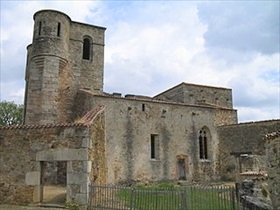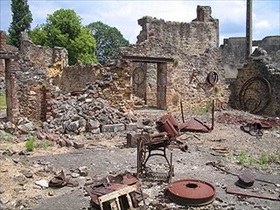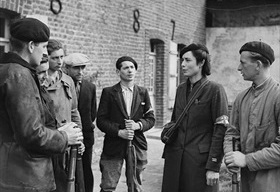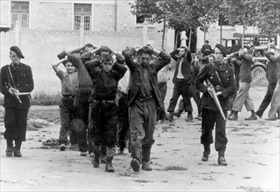TERROR SHOOTING IN PARIS METRO
Paris, Occupied France · August 21, 1941
On this date in 1941 in Paris, a 22-year-old member of the French Resistance named Georges Pierre, who took the nom de guerre of Fabien or Fredo, fired two bullets into the back of Alfons Moser, a young German naval officer, at the Barbes Rochechouart metro station. These were the opening shots of the partisan warfare that would soon paralyze Axis forces all over France. Adolf Hitler demanded the immediate execution of one hundred hostages. The number was reduced to ten. Marshal Philippe Pétain, the 85‑year‑old titular head of the French government, proposed that his Vichy regime carry out the executions by guillotine in public; however, German military authorities, fearing repercussions from the French public, insisted that the executions be done in private. Beginning on August 28 and over the next several days, French judges sent eleven innocent Frenchmen to their deaths. Between August and the end of 1941, there were 68 serious attacks on Germans in and around Paris alone. The brutality with which these attacks were met, the mass executions of hostages, plus the growing wartime shortages of food, were at last combining to turn average French citizens against their German occupiers and French collaborators. Pétain himself remarked that “from various parts of France, I begin to feel an unpleasant wind getting up.” Alfons Moser’s death marked a turning point in the French Resistance, and the wind never let up. Large and small resistance operations culminated in two horrific German reprisals on June 9–10, 1944, in Tulle and Oradour-sur-Glane in central France. In reprisal for résistants killing, harrying, and slowing them down as they attempted to reach the Allied beachheads in Normandy, men of the 2nd SS Panzer Division “Das Reich,” one of Hitler’s most elite armor units, rounded up 500 men and women of Tulle and hanged 99 from balconies and street lights. The next day the bloodthirsty troopers ringed Oradour-sur-Glane, herded the women and children into a church, which they set on fire, and shot the men, killing 642 villagers. According to French sources, between May 1940 and September 1944 a total of 6,000 Frenchmen were massacred (massacrés) by the Germans and their “allies,” 25,000 were shot (fusillés), and 27,000 résistants died during deportation, not to mention the tens of thousands of déportés who died following incarceration.
![]()
[amazon_carousel widget_type=”ASINList” width=”600″ height=”200″ title=”Recommended Reading” market_place=”US” shuffle_products=”False” show_border=”False” asin=”0760344914,037550608X,0061650714,1847391567,0231124694,285025567X,0199254575,1846030765,0312423594,0300126018″ /]
German Atrocities in France and the French Resistance
 |  |
Left: The church in Oradour-sur-Glane in which 245 women villagers or visitors and 205 children were burnt to death or shot as they attempted to escape. Their husbands, sons, and brothers were marched to nearby barns, lined up, and shot. One woman and six men survived the massacre. After the war a new village was built on a nearby site. On the orders of French president Charles de Gaulle the original village has been maintained as a museum and permanent memorial to the cruelty of the Nazi occupation. Photo taken June 11, 2004.
![]()
Right: Wrecked hardware (bicycles, sewing machine, etc.) six decades later, left as a reminder of the barbarity of the German reprisal in Oradour-sur-Glane. In January 1953 a military tribunal in Bordeaux heard the case against the surviving 65 of the approximately 200 German soldiers who had been involved in the reprisal. Only 21 defendants were in court. On February 11, 1953, with one exception all were convicted of war crimes.
 |  |
Left: During the Allied invasion of Normandy, the Maquis (rural guerrilla bands in Brittany and southern France) and other groups played an important role in delaying German mobilization. The FFI (Forces Françaises de l’Interieur, French irregulars) blew up railroad tracks and repeatedly attacked German Army equipment and garrison trains on their way to the Channel coast. This photo shows members of the Maquis in La Tresorerie near Boulogne-sur-Mer, northern France, September 14, 1944.
![]()
Right: Resistance members captured by the Milice, a Vichy French paramilitary force, July 1944. Milice’s membership may have reached 25,000–35,000 (including part-time members and non-combatants) by 1944. Milicien operated in both the “free zone” (Vichy France) and in the German zone (zone occupée), including Paris. Many milicien were imprisoned for treason, executed following courts-martial, or killed by résistants and civilians who revenged themselves in the épuration sauvage (pursuit of Nazi collaborators) that took place after the war’s end.
Oradour Sur Glane: Death of a French Village
![]()

 History buffs, there is good news! The Daily Chronicles of World War II is now available as an ebook for $4.99 on Amazon.com. Containing a year’s worth of dated entries from this website, the ebook brings the story of this tumultuous era to life in a compelling, authoritative, and succinct manner. Featuring inventive navigation aids, the ebook enables readers to instantly move forward or backward by month and date to different dated entries. Simple and elegant! Click
History buffs, there is good news! The Daily Chronicles of World War II is now available as an ebook for $4.99 on Amazon.com. Containing a year’s worth of dated entries from this website, the ebook brings the story of this tumultuous era to life in a compelling, authoritative, and succinct manner. Featuring inventive navigation aids, the ebook enables readers to instantly move forward or backward by month and date to different dated entries. Simple and elegant! Click 











